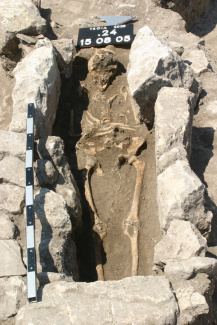Sleuthing out pathogens in 800-year old skeleton gives clues to modern disease

 While curating skeletal remains from a Byzantine-era graveyard near what was once ancient Troy, physician and archeologist Henrike Kiesewetter of Tübingen University noted the signs of a hard-fought lifestyle: joint and spine degeneration, infectious disease, short lifespans, rotting teeth, infant deaths, and malnutrition. But when she looked at the remains of one 800-year-old woman (pictured at right), she noticed something particularly unusual: two strawberry-sized calcified nodules below the ribs at the base of the chest.
While curating skeletal remains from a Byzantine-era graveyard near what was once ancient Troy, physician and archeologist Henrike Kiesewetter of Tübingen University noted the signs of a hard-fought lifestyle: joint and spine degeneration, infectious disease, short lifespans, rotting teeth, infant deaths, and malnutrition. But when she looked at the remains of one 800-year-old woman (pictured at right), she noticed something particularly unusual: two strawberry-sized calcified nodules below the ribs at the base of the chest.
“The preliminary thought was that these were tubercles arising from tuberculosis,” said Caitlin Pepperell, MD, assistant professor, Infectious Disease and Department of Medical Microbiology and Immunology. Dr. Pepperell, an expert in tuberculosis evolution, teamed up with Hendrik Poinar, PhD of McMaster University to conduct DNA analysis. Their research teams soon found that the nodules were unlike any that had ever been described, full of extraordinarily well-preserved ‘ghost cells’ with DNA encased inside concentric spheres of calcium. “Calcification made little tiny suitcases of DNA and transported it across an 800-year timespan,” said Dr. Pepperell.
“We think that the individual cells in this abscess were encased in mineral shells that preserved not just the cells, but also the architecture of the tissue. That level of preservation may be unusual, because you would have to have all the cells in place and have the calcification happen quickly,” said Dr. Pepperell.
Enough DNA was preserved, in fact, to reconstruct two genomes of the two species of bacteria that researchers believe infected the woman and led to her death. The cause of her demise wasn’t tuberculosis, though.
The woman had been pregnant and suffered a severe infection, likely chorioamnionitis—a bacterial infection of the placenta, amniotic fluid and membranes surrounding the fetus. In addition to the woman’s DNA and that of the bacteria causing her infection, researchers identified ancient Y chromosome DNA, probably that of a male fetus. The nodules in the woman’s remains were calcified abscesses.
“It was amazing (that it wasn't tuberculosis). No one thought that we would be getting a picture of maternal infections or this type of infection from archeological remains. The focus in ancient DNA samples has been on tuberculosis, leprosy, plague, H. pylori,” said Dr. Pepperell.
More surprises were in store when they team conducted the evolutionary analysis. The two pathogens they found were Gardnerella vaginalis, which occurs in modern pregnancy-related infections, and ancient form of Staphylococcus saprophyticus, which today is second only to E. coli as a cause of urinary tract infection among women of reproductive age.
But while DNA analysis indicated that the ancient G. vaginalis strain was relatively similar to modern isolates, analysis of S. saprophyticus Troy indicated that it is more closely aligned with strains found in livestock rather than humans. The researchers speculate that because agrarian communities living in Troy in the early 13th century CE lived closely with their cattle, the S. saprophyticus strain she became infected with had originated in her environment. “This suggests that the pool of S. saprophyticus bacteria that cause human genitourinary disease today is different than the pool of bacteria that caused disease at that place and time. It was surprising to me that this agent of UTIs can be acquired from the environment—one would think person-to-person transmission would be more likely,” said Dr. Pepperell.
“That changes how we think about how pathogenicity and virulence emerge, and how that process works from an ecological and evolutionary perspective.”
Additional authors included Alison Devault, Tatum Mortimer, Andrew Kitchen, Jacob M Enk, G Brian Golding, John Southon, Melanie Kuch, Ana Duggan, William Aylward, Shea Gardner, Jonathan Allen, Andrew King, Gerard Wright, Makoto Kuroda, Kengo Kato, Derek EG Briggs, Gino Fornaciari, and Edward Holmes.
Resources:
- Devault AM, et al. 2017. A molecular portrait of maternal sepsis from Byzantine Troy. eLife 6:e20983.
- “Byzantine skeleton yields 800-year-old genomes from a fatal infection,” UW-Madison, January 10, 2017.
- "UW researcher unlocks story of 800-year-old skeleton," Milwaukee Journal Sentinel, January 9, 2017.
- "Ancient Bacteria Yield Clues for Woman's Dramatic Cause of Death 800 Years Ago," ABC News, January 12, 2017